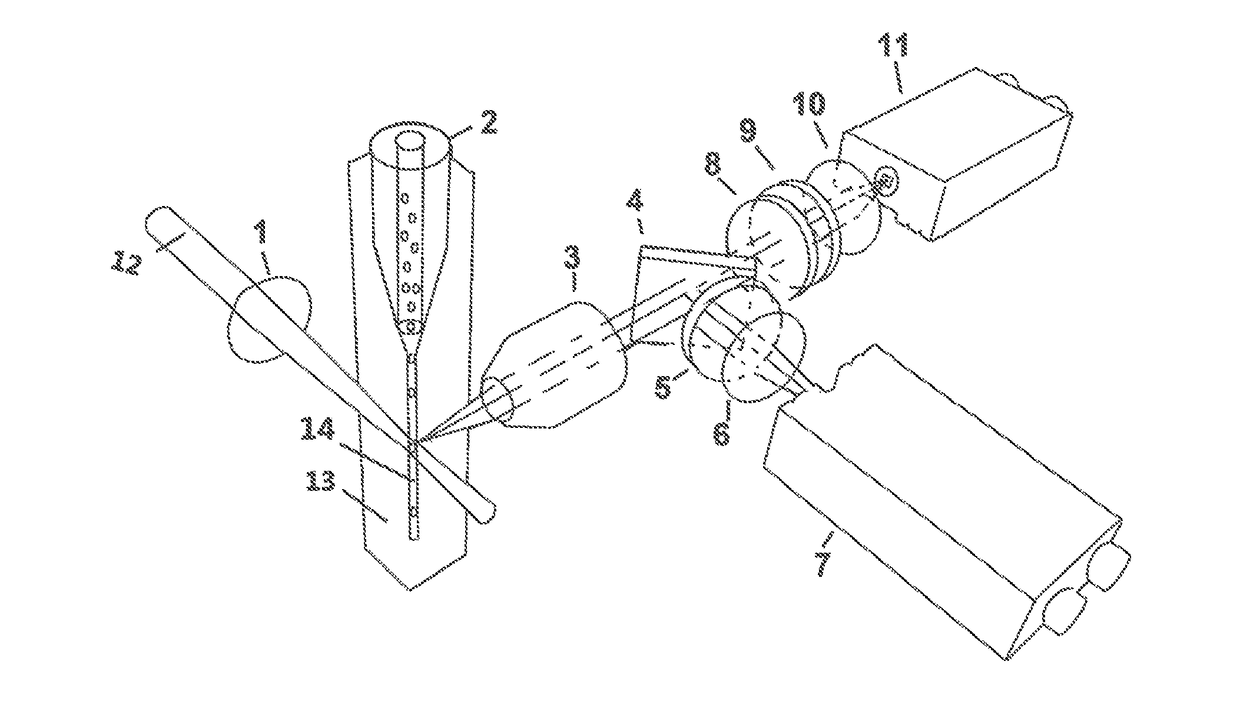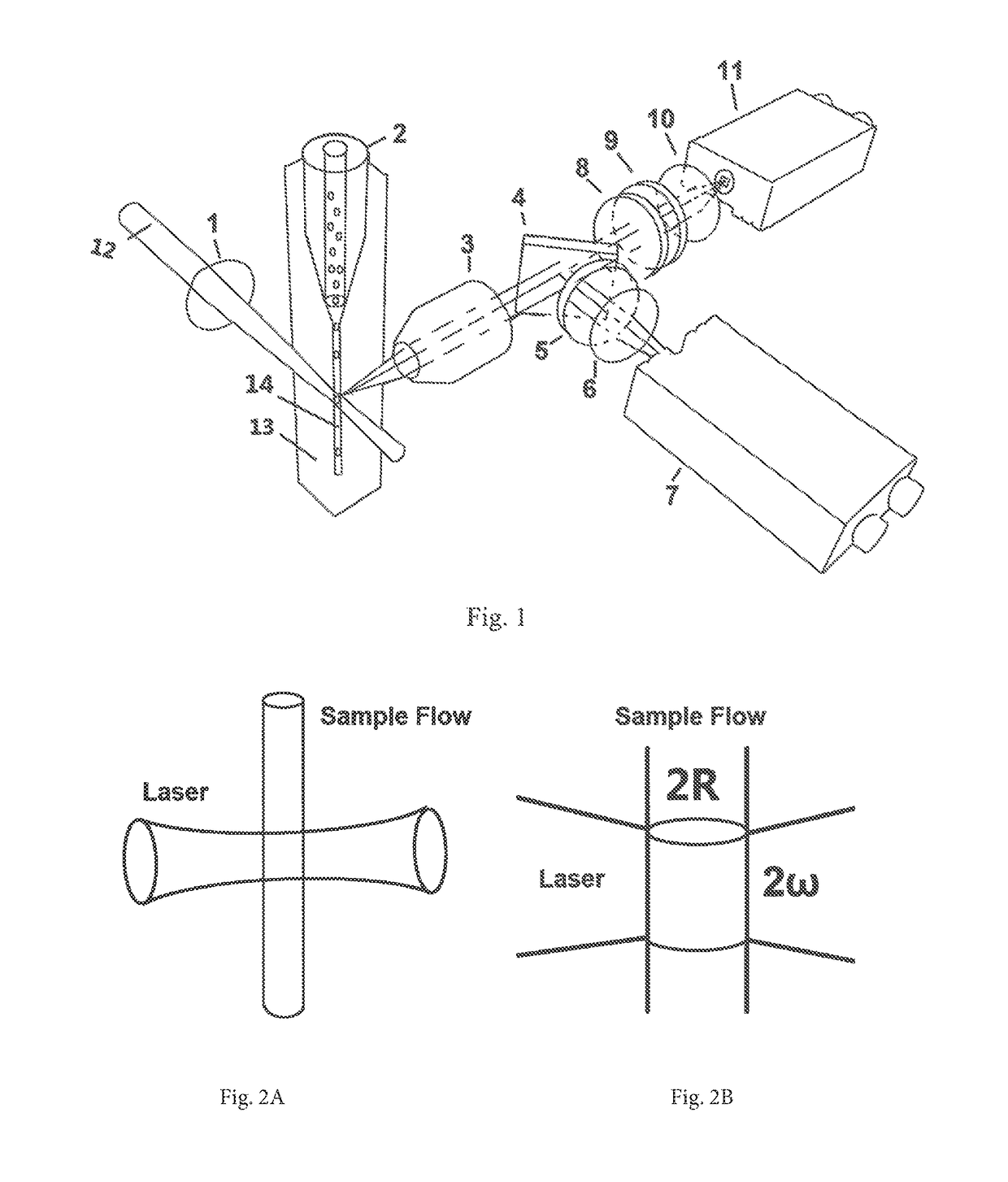Method for detecting nano-particles using a lens imaging system with a field stop
a nano-particle and imaging system technology, applied in the field of instruments, can solve the problems of low signal strength, inability to detect nano-particles with smaller particle sizes, and inability to detect smaller nano-particles with lower refractivity
- Summary
- Abstract
- Description
- Claims
- Application Information
AI Technical Summary
Benefits of technology
Problems solved by technology
Method used
Image
Examples
example 1
[0062]With reference to the light path system shown in FIG. 1 and the liquid flow system shown in FIG. 3, a sample liquid to be tested (suspension liquid of polystyrene nano-spheres with 44 nm particle size at a concentration of 2×109 particles / mL) is pressed with nitrogen at 150 kPa pressure into an pressure-tight sample tube 2, and the pressure of the nitrogen is regulated so that the volumetric flow rate of the sample liquid is 2 nL / min. Wherein the sample tube is a quartz capillary tube with 40 μm inner diameter and 240 μm outer diameter, the terminal of the capillary tube is ground to an approx. 12° taper. The sample tube is inserted into a sheath fluid cavity from top to bottom in an axially parallel state, the sheath fluid cavity is a cuboid-shaped cavity formed by quartz glass, with 250 μm×250 μm cross section and 20 mm axial length, and the terminal of the sample tube is positioned at 8 mm above the top of the sheath fluid cavity in axial direction. A sheath fluid 13 flows ...
example 2
[0075]The measurement is made with the method described in the example 1, but the difference is: the sample liquid to be tested is a suspension liquid of silicon dioxide nano-spheres with 40 nm particle size at a concentration of 2×109 particles / mL.
[0076]The relational diagram of the electrical signals obtained through conversion using an APD (serves as the photoelectric detector 7) vs. time is shown in FIG. 6B1, and the calculated S / N is 10. It can be seen from the result in FIG. 6B1: the scattered light from a single silicon dioxide nano-sphere with 40 nm particle size can be clearly distinguished from the background.
[0077]The frequency distribution histogram of the peak area of scattered light obtained through conversion using an APD (serves as the photoelectric detector 7) is shown in FIG. 6B2, and the calculated CV is 40%. Based on the Mie scattering theory, a CV of particle size distribution can be obtained, i.e.
[0078]CV=((1+40%)6-1)×100%=5.8%.
That value is essentially the ...
example 3
[0079]The measurement is made with the method described in the example 1, but the difference is: the sample liquid to be tested is a suspension liquid of gold nano-particles with 10 nm particle size at a concentration of 2×109 particles / mL.
[0080]The relational diagram of the electrical signal obtained through conversion using an APD (serves as the photoelectric detector 7) vs. time is shown in FIG. 6C1, and the calculated S / N is 10. It can be seen from the result in FIG. 6C1: the scattered light from a single gold nano-particle with 10 nm particle size can be clearly distinguished from the background.
[0081]The frequency distribution histogram of the peak area of scattered light obtained through conversion using an APD (serves as the photoelectric detector 7) is shown in FIG. 6C2, and the calculated CV is 55%. Based on the Mie scattering theory, a CV of particle size distribution can be obtained, i.e.
[0082]CV=((1+55%)6-1)×100%=7.6%.
That value is essentially the same as the CV (7.1...
PUM
| Property | Measurement | Unit |
|---|---|---|
| volume | aaaaa | aaaaa |
| volume | aaaaa | aaaaa |
| volume | aaaaa | aaaaa |
Abstract
Description
Claims
Application Information
 Login to View More
Login to View More - R&D
- Intellectual Property
- Life Sciences
- Materials
- Tech Scout
- Unparalleled Data Quality
- Higher Quality Content
- 60% Fewer Hallucinations
Browse by: Latest US Patents, China's latest patents, Technical Efficacy Thesaurus, Application Domain, Technology Topic, Popular Technical Reports.
© 2025 PatSnap. All rights reserved.Legal|Privacy policy|Modern Slavery Act Transparency Statement|Sitemap|About US| Contact US: help@patsnap.com



